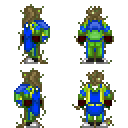Difference between revisions of "Diona"
Shadeykins (talk | contribs) |
Shadeykins (talk | contribs) |
||
| Line 2: | Line 2: | ||
= Mechanics [[file:Wrench.png|32px]]= | = Mechanics [[file:Wrench.png|32px]]= | ||
'''Physiology''' | |||
* Can speak Rootsong. Use this in game by typing say :q | * Can speak Rootsong. Use this in game by typing say :q | ||
| Line 9: | Line 9: | ||
* Doesn't breathe. | * Doesn't breathe. | ||
'''Boons''' | |||
* Light heals/provides nutrition. | * Light heals/provides nutrition. | ||
| Line 21: | Line 20: | ||
* Pain immunity. | * Pain immunity. | ||
'''Maluses''' | |||
* Starves in darkness. | * Starves in darkness. | ||
Revision as of 18:12, 28 December 2018
The Dionae are a race of plant-like beings with gestalt consciousness, composed of many smaller Nymphs. Their world of origin is unknown.
Mechanics 
Physiology
- Can speak Rootsong. Use this in game by typing say :q
- No blood/bones.
- Doesn't breathe.
Boons
- Light heals/provides nutrition.
- Healed by radiation (still causes mutation).
- Low-pressure immunity.
- Cold immunity.
- Pain immunity.
Maluses
- Starves in darkness.
- Takes extra burn damage.
- Slower movement (-5 speed).
- Atrazine is fatal.
Dionae and YOU
Greetings, esteemed crewmember!
In an effort to encourage inter-species cooperation and workplace efficiency, NanoTrasen has compiled a series of helpful guides on the various species that you may be working with!
(NOTE: If you are a member of the species this guide pertains to, please give it to the nearest crewmember of another species)
This particular guide refers to the species known as the Dionae (singular: Diona).
Diona Naming Schemes
Dionae do not have names as such, though will adopt individual identifiers when required by their environment. Usually they supply an often long and poetic description of a memory they consider fundamental to their makeup: for instance, 'the glitter of starlight across the face of the iron mountain and the deep note of the planet-song'. However, due to their noted pattern of mimicry and adaptation, more conventional (if unusual) names are not uncommon.
Diona Physiology

|
| A typical Diona gestalt |
Dionae are highly unusual amongst most organisms in that they appear to be almost entirely adapted for life in the vacuum of space. Beyond their initial nymph forms, they are able to survive on nothing more than stellar radiation and the occasional mote of interplanetary dust, requiring neither atmosphere nor gravity. However, the earliest stage of their life-cycle, the nymph, does require a more sheltered and nutritious environment in which to germinate, such as a chemical-rich asteroid or the interior of a spacecraft.
While the name “Diona” is usually used to refer to the humanoid representatives of the species, a single member of the family is technically a diona nymph - a rather small, insect-like being. The nymphs have the ability to join themselves into a larger structure - a gestalt. A gestalt can usually be treated as a single being due to the diona nymphs merging their consciousness with the larger structure, but it’s possible for a nymph to be a part of a gestalt and still retain its agency. The causes of such inconsistent behavior are not yet known, but likely stem from simple genetic defects of the nymphs.
A single gestalt can range in size from a small clump of a few nymphs to a large station-size structure, the largest of which are sometimes referred to as “reefs”. In order for a gestalt to be able to serve in Nanotrasen facilities, it must be able to function as the rest of the crew and as such, a humanoid shape involving a head and a set of limbs is expected.
Due to their construction, gestalts have a hard time wearing most normal clothing meant for regular crew members. While shoes and jumpsuits are normally flexible enough to fit, space suits and similar wear most likely will not. However, due to their unusual biology, Diona are able to operate in environments where most species would require a hardsuit.
The Rootsong Language
Dionae possess a mysterious inborn language, which is referred to as “Rootsong” in Galactic Common. They all appear to understand it innately, though its precise rules and mechanisms are difficult to decipher. It seems to operate via oscillating signals on any available kind of wave, whether sound waves for nymphs and crew-sized dionae or microwave transmissions for the larger gestalts.
Curiously, Diona are able to readily acquire the languages of other races via a fascinating biological mechanism. As nymphs, they often steal tiny amounts of blood from members of other species, and in doing so acquire knowledge including language and general cultural background. It is believed that during this, their feelers briefly interface with the donor’s nervous system in the same way they would with that of another nymph when forming a gestalt, allowing them to take a "snapshot" of synaptic activity. While the precise nature of this process is still unknown, it is a matter of no small scientific interest. Crew members are advised that diona nymphs may do this without warning, but also that the process is entirely benign. The amount of blood taken is medically insignificant, and the process has not been noted to have any long-term effects on the subjects.
The Diona Homeworld?
It is unknown if the Dionae even have a homeworld, as their biology suggests they have been adapted to life in space for a very long time. Their oldest known gestalts are either ignorant of the origins of their species, or unwilling to divulge such, and scientific data has been thus far inconclusive. A population from the Kidan homeworld of Aurum was discovered concurrently with the Kidan, but the Dionae were known to the Skrell (and possibly others) long before this. Thus, it is commonly believed that the Aurum population originated from a wayward Gestalt that fell out of orbit onto the planet.(For more information on the Dionae of Aurum, see Kidan History)
Dionae have been observed in a string of adjacent star systems, usually as large gestalts orbiting close to stars or gas giants. They are believed to have spread “naturally,” via gravitational slingshots from massive bodies. However, they have also been observed in isolated systems away from this cluster. Orbital dionae can adjust their orbits more favorably via gathering and hurling small amounts of matter, or by flattening their gestalts into solar sails. However, such adjustment takes many years, and would likely not allow them to travel to such distant stars on their own. Due to this, and the characteristics of their nymphs, some speculate that they received assistance from unknown, ancient spacefarers.
A Brief History 

|
| Unknown |
The earliest record of the Diona appears in 2204, when Skrellian exploratory craft came across the system known to human astronomers as Epsilon Ursae Minoris during a scouting expedition. They dutifully flagged it for review, as it was a ternary system with a triad of stars, and went on their way, noting a few strange readings from the outer coronae of the system's core bodies.
Only when the mining fleets of a Skrell industrial consortium arrived in 2234 did the readings become explained. A thick belt of drifting matter was slung in a wide arc around the three central stars, which at first appeared to be a complex web of energy-harvesting machines. As they neared, the ships received a directed signal from the belt, which had the scientists aboard frenzied with excitement: Something was there and very pleased to meet them.
Over the next several decades, further science vessels were brought in and the strange electromagnetic language of the creatures that came to be called Dionae was painstakingly decrypted. The scientists learned that the strange, immense structures were conglomerates of plantlike creatures, fuelled by hard radiation, asteroid impacts and a complex interactions with the superheated gas they gathered from the stars’ coronae.
Eventually, over several years (due to the slow speed of thought of the largest Dionae gestalts) an agreement was reached. The scientists would take from the Dionae several samples and seeds, and sow them in other star systems. In exchange, the gestalts would allow the surveyors and miners to establish habitation modules on and in themselves, in order to harvest the materials from stellar ejecta and asteroids they had collected over the eons.
Currently Dionae can be found in almost all corners of the known galaxy, sometimes living on stations and colonies, but often simply drifting in space, slowly thriving on what little they find there. Contact between spacefarers and other large, established gestalts has resulted in many similar exchanges, speeding their dispersal.
Diona Culture
Dionae do not have a culture in the sense of other species, as thought occurs slowly in their larger gestalts, and when clustered together they seem to operate more akin to a single tremendous, dispersed individual than as a group. Until recently, gestalts in different star systems have had extremely limited opportunity to communicate with each other. The only thing most gestalts have in common is the language they can speak, and the drives of their life cycle. Their only universal interest seems to be the accumulation of knowledge and the spread of their species. Religion is rare among the Dionae, most of them not paying attention to metaphysical matters at all, as the species, thanks to its biology, rarely faces death.
The nymphs and humanoid-sized Dionae encountered by crew members consequently seem rather individualistic, at least until their life cycle leads them to eventually merge with a larger body. However, as with most species, these individuals can vary wildly, especially due to the mixing of traits from those they mimic or absorb from, despite their common beginnings and eventual endings
Present Day
While widely dispersed, and perhaps possessing vast knowledge of science and the history of the Galaxy, the Dionae cannot be considered major galactic actors as they do not act as a group. They seem content to live symbiotically with the various spacefaring peoples, and do not seem interested in involving themselves with galactic affairs, aside from certain rare individuals. They are known to be generally friendly, their reefs showing a fondness for sheltering distressed ships, but they seldom act politically.
However, Dionae do have a subtle yet significant economic influence. They have proved invaluable to the ecology of spacecraft all over the galaxy, their nymphs protecting hydroponic food supplies from pests, improving the growth of other plants, or even serving as an adequate food source themselves. Occasionally these nymphs can grow into crew-sized gestalts and prove even more useful. This has been the main means for their recent spread through the Galaxy. Some younger gestalts have been known to form themselves into structural components for Skrell ships, or even serve as entire ships when fitted with engines.
Due to these several services they can provide, you can find many representatives of the species onboard Nanotrasen vessels. You may even find a gestalt as your supervisor, thanks to our foreign species involvement programs.
Remember, crewmember, mutual respect and cooperation are the cornerstones of success and productivity!













